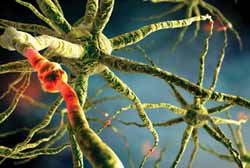Finding the Sweet Spot

Figure 1: Neural cell-specific modifications to chromosomal proteins govern the production of Gnt-IX and thereby ensure that branched O-mannose glycan production is restricted to these cells. <br>Copyright : 2011 iStockphoto/sitox <br>
Many proteins are adorned with carbohydrate chains called glycans that can dramatically alter their stability, localization or function. These diverse sugars are assembled and modified by a variety of glycosylating enzymes, with some glycans exclusively manufactured within specific organs or tissues.
The â1,6-branched O-mannosyl glycan appears only in the mammalian brain. Naoyuki Taniguchi’s team at the RIKEN Advanced Science Institute in Wako recently characterized the enzyme, N-acetylglucosaminyltransferase IX (GnT-IX, also called GnT-Vb) that produces this particular glycan variant1 (Fig. 1). “We knew that some glycan-synthesizing enzymes are expressed in restricted tissues, but did not know how they are expressed,” says Yasuhiko Kizuka, a researcher in Taniguchi’s laboratory. “This led us to investigate how GnT-IX is specifically expressed in the brain.”
Many genes are regulated by so-called ‘epigenetic mechanisms’, in which gene expression is modulated via modification of the histone protein scaffold that supports chromosomal DNA, and the researchers began by examining this possibility. When histone proteins undergo a modification known as acetylation, nearby genes are typically activated; conversely, removal of this acetylation has an inhibitory effect.
Taniguchi and colleagues determined that the gene encoding GnT-IX is typically maintained in an inactive, non-acetylated state in 3T3-L1, a cell line derived from the fibroblasts that form connective tissue. However, when the researchers treated these cells with a drug that promotes histone acetylation, they strongly expressed GnT-IX. The brain tumor-derived Neuro2A cell line, however, naturally expresses high levels of GnT-IX. The researchers found that these cells normally maintain the chromatin near this gene in a state that stimulates activation.
In subsequent experiments, Kizuka and Taniguchi not only identified specific DNA sequences that directly regulate GnT-IX activity, but also two proteins that bind to these sites to drive expression. They found one of these factors, CTCF, in both 3T3-L1 and Neuro2A cells, but its recruitment to the GnT-IX gene was far stronger under the favorable histone modification conditions found in the latter cells.
Intriguingly, a preliminary screen of four other glycosylation enzymes suggested that similar mechanisms govern their tissue-specificity. “Our work suggests that expression of many other glyco-genes could be regulated epigenetically,” says Kizuka.
In future studies, the researchers intend to explore how this regulatory mechanism plays into the bigger picture of glycan function. “Our group has been trying to elucidate the ‘glycan cycle’—how glycans are dynamically synthesized, play diverse roles and are degraded—using a systems biology approach,” says Kizuka. “This work tells us that epigenetic regulation is a part of this cycle.”
The corresponding author for this highlight is based at the System Glycobiology Research Group, RIKEN Advanced Science Institute
Media Contact
All latest news from the category: Life Sciences and Chemistry
Articles and reports from the Life Sciences and chemistry area deal with applied and basic research into modern biology, chemistry and human medicine.
Valuable information can be found on a range of life sciences fields including bacteriology, biochemistry, bionics, bioinformatics, biophysics, biotechnology, genetics, geobotany, human biology, marine biology, microbiology, molecular biology, cellular biology, zoology, bioinorganic chemistry, microchemistry and environmental chemistry.
Newest articles

High-energy-density aqueous battery based on halogen multi-electron transfer
Traditional non-aqueous lithium-ion batteries have a high energy density, but their safety is compromised due to the flammable organic electrolytes they utilize. Aqueous batteries use water as the solvent for…

First-ever combined heart pump and pig kidney transplant
…gives new hope to patient with terminal illness. Surgeons at NYU Langone Health performed the first-ever combined mechanical heart pump and gene-edited pig kidney transplant surgery in a 54-year-old woman…

Biophysics: Testing how well biomarkers work
LMU researchers have developed a method to determine how reliably target proteins can be labeled using super-resolution fluorescence microscopy. Modern microscopy techniques make it possible to examine the inner workings…





















